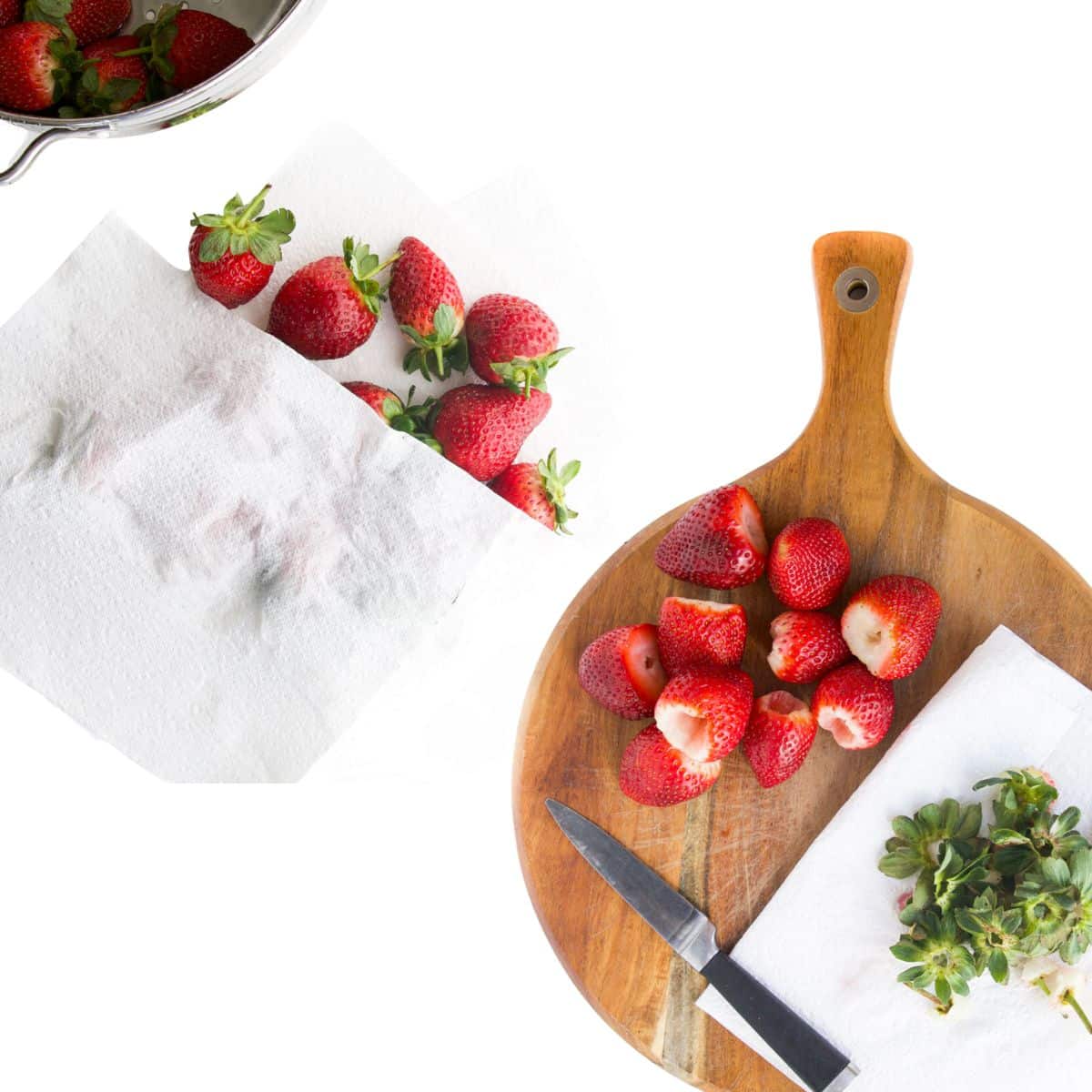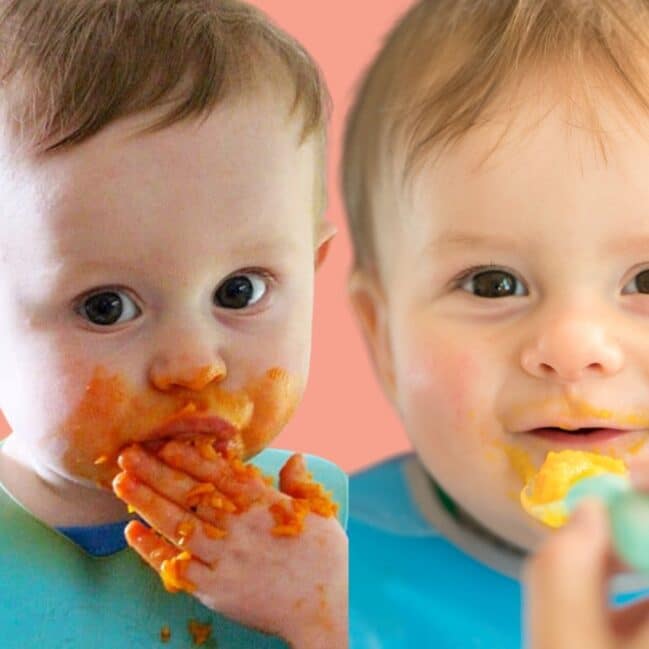Easily introduce your bundle of joy to the world of strawberries on their exciting feeding journey with this guide on How to Serve Strawberries for Baby-Led Weaning (BLW).

Jump to:
When to Offer Strawberries to Babies
Soft, ripe strawberries can be introduced to your baby once they have begun their solid foods journey, usually around 6 months. However, it's vital to consider your baby's developmental readiness rather than just following a calendar.
Babies develop at their own pace. Before offering finger foods, your baby should be able to sit up unsupported or with little support, have good head control, reach out to grab objects and their tongue-thrust reflex should be diminished. Read more in this baby-led weaning guide.
While strawberries can be introduced as a finger food at this time, they are a potential choking hazard and need to be prepared in the correct and safe manner.
Choosing Strawberries
Selecting the right strawberries is essential for ensuring the best flavour and quality. When choosing strawberries look at their:
- Colour: Look for strawberries that are vibrant and evenly coloured, with no to little white or green areas. They should be a rich, deep red hue.
- Texture: Opt for strawberries with a glossy appearance and smooth, unblemished skin. Avoid berries with wrinkled, mushy, or bruised spots.
- Aroma: Smell the strawberries. A sweet, fruity aroma indicates ripeness. If they don't have a noticeable scent, they might not be fully ripe.
How to Prepare Strawberries for BLW
When preparing fresh strawberries for baby-led weaning, follow these simple steps:

- Wash and Dry: Begin by washing the strawberries to remove any dirt, pesticide residues or even tiny insects living on them. After washing, gently pat the strawberries dry with a paper towel to eliminate excess moisture.
- Hull and Serve According to Age: Using a small sharp knife, cut in a circular motion around the green top. Carefully remove the hull. Serve/ cut according to your baby's age and developmental stage (details below).
How to Cut/Serve Strawberries for Baby-Led Weaning (by months of age)

6-8 months
Strawberries that are extra large, soft, and ripe can be offered whole, with the stem removed.
- Large: Bigger is safer for younger babies, look for large strawberries that won't be able to fit entirely into your child's mouth.
It will force them to take bites and help reduce the risk of choking. - Ripe: It is important that you serve soft and juicy strawberries. Gently press the strawberry between your thumb and forefinger. It should smoosh with gentle pressure.
Firm strawberries are not suitable to offer your baby.
If the whole berry is munched down to a size that raises a choking concern, (small enough to get in your baby's mouth but large enough to block their air-hole) replace it with a larger one. Safety is key.

If your strawberries are on the small side the safest and best way to serve them would be mashed or pureed. A common misunderstanding is that you should avoid serving purees when doing the baby-led weaning feeding method. However, this isn't true
You can incorporate strawberries that have been mashed or strawberry puree into oatmeal, yogurt or other baby-friendly foods. Alternatively, pre-load a spoon and place it on the table or your baby's hand.
9-11 months
When your baby has developed their pincer grasp and is able to pick up smaller pieces of food you can offer thin slices. Just make sure that the strawberries are soft enough to be squished. Thin slices may be difficult to pick up from a plate/ tray with little hands. You may find it a good idea to serve them in a suction bowl which will be easier for them to scoop and pick up
12-24 months
Maintain serving a large whole strawberries, sliced strawberries or mashed as a safe option. As your little one progresses, consider reintroducing larger portions, such as whole or quartered strawberries. The level of ripeness and softness of the berry influences the risk; opt for softer ones to minimize potential hazards.
Strawberry Baby Food Ideas
Enjoy these different ways to serve strawberries to you baby.
- Try serving mashed or finely diced strawberries in oatmeal like in this strawberry overnight oats.
- Cook strawberries with chia seeds to make a strawberry chia seed jam. Great for spreading on toast fingers.
- Try making strawberry pancakes or replacing blueberries with strawberry pieces in these baby blueberry muffins.

Video
Strawberry for Babies - FAQs
Strawberry isn't one of the top allergens, but some babies may experience a rash around the mouth due to the fruit's acidity. Excess consumption can also lead to or worsen nappy/diaper rash.
Those with Oral Allergy Syndrome, especially those allergic to birch pollen, may be sensitive to raw strawberries. This syndrome generally causes mild, temporary mouth itching or burning which usually goes away on its own. Cooking the strawberries can reduce the reaction.
When introducing strawberries the first time, as with all foods, offer a small amount. Gradually increase it over time if there are no reactions
Strawberries are packed with important nutrients. They are an excellent source of Vitamin C, which enhances immunity and aids in iron absorption of plant-based foods. With their high fibre content, they promote healthy digestion and reduce the risk of constipation. Additionally, strawberries contain an array of antioxidants to support a baby's overall health.
Yes, they can be. Avoid small, round and firm strawberries and always make sure to serve soft berries that are cut or prepared in a safe way, depending on the age and stage of your baby. As with all foods, always provide a safe eating environment and make sure to keep a close eye when serving your baby strawberries.
Start by sorting through your strawberries and remove any that look bad or are spoiled.
Keep Whole and Unwashed: Store the remaining strawberries whole and unwashed. Leave the green leaf tops intact, as this helps retain freshness.
Use Paper Towels: Line the storage container with paper towels. This will help absorb any excess moisture and prevent the strawberries from becoming too damp.
Single Layer: If possible, store the strawberries in a single layer. This helps prevent mold from spreading if one strawberry starts to go bad.
Wash Before Eating: Avoid washing the strawberries before storing them. Instead, wash them right before you're ready to eat them to preserve their freshness.
Optional Vinegar Bath: If you prefer to wash before storing, you can give your strawberries a vinegar-water bath. Mix 1 part vinegar with 3 parts water, dip the strawberries, drain, and then pat them dry as much as possible. Afterwards, transfer them to a paper towel-lined container and loosely place the lid on.
By following these steps, you can maximize the shelf life and freshness of your strawberries.
More Guides On How To Serve Foods For BLW
Disclaimer: This information is intended for general use only. It is not medical advice and is not intended to replace the personalised care and advice given to you by your health professional. I am not a health professional and I do not know your baby. You should always discuss any concerns or questions about the health and well-being of your baby with a healthcare professional. Please refer to my full disclaimer for more info.
Looking for more healthy kid recipes?Sign up for my free recipe newsletter to get new family friendly recipes in your inbox each week! Find me sharing more kid-friendly inspiration on Pinterest and Instagram.

Strawberries for Baby Led Weaning
Ingredients
- 1 Large Strawberry , washed, dried and hulled.
Instructions
6 months +
- Offer whole large, soft strawberries.
- Alternatively, offer the strawberry mashed or as strawberry puree on a preloaded spoon.
9 months +
- Offer as 6 months + or cut into thin slices.
12 months - 24 months
- Offer as 6 months +, 9 months + or as quarters.
Video
Recipe Notes
- Bigger is safer for younger babies, look for large strawberries that won't be able to fit entirely into your child's mouth. It will force them to take bites and help reduce the risk of choking.
- It is important that you serve soft and juicy strawberries. Gently press the strawberry between your thumb and forefinger. It should smoosh with gentle pressure. Firm strawberries are not suitable to offer your baby.
- If the whole berry is munched down to a size that raises a choking concern, (small enough to get in your baby's mouth but large enough to block their air-hole) replace it with a larger one. Safety is key.
- When your baby has developed their pincer grasp and is able to pick up smaller pieces of food you can offer thin slices
- This is a guide for general use, it is not medical advice. Babies develop at their own pace. It is vital to consider your baby's developmental readiness rather than just following a calendar.











Leave a Comment